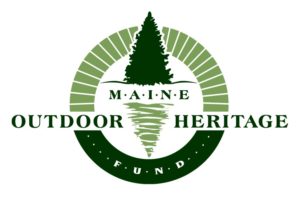Penobscot River Pinnipeds
Welcome to our research project site, where we will provide regular field updates, introduce you to our pinnipeds of the Penobscot River, and share with you our research findings.
Welcome to our research project site, where we will provide regular field updates, introduce you to our pinnipeds of the Penobscot River, and share with you our research findings.
Harbor seals are the smallest and most common of the seals we observe from the coast in Maine. Today, their population throughout the Northeast US numbers approximately 75,000 (Hayes et al. 2019). Harbor seals can be seen year-round in coastal waters or hauled out on the many rocky outcroppings, islands, and beaches of Maine’s coastline. Females give birth to their pups in May and June and wean their pups within 4-6 weeks. As adults, harbor seals can reach 4-5 feet in length and 200-250 pounds in weight. To tell them apart from gray seals, look for the distinct dog-like resemblance of their face.
Gray seals have become an increasingly common sighting from the coast in Maine, as their populations have recovered from historical exploitation over just the past two decades. Today, there are an estimated 27,000 gray seals in US waters, and an additional 400,000 gray seals in neighboring Canadian waters (Hayes et al. 2019). Gray seal females in our region give birth to their pups between December and February and wean their pups within 2-3 weeks. As adults, male gray seals can reach 7-8 feet in length and over 700 pounds in weight. Compared to the cocker spaniel face of a harbor seal, gray seal faces have been compared to the shape of horse heads.
Photo credit: Lauri Leach
The Penobscot River, the second-largest river system in New England, runs from the Maine/Quebec border, past our campus, and into the Penobscot Bay Estuary. The river provides a thoroughfare for anadromous fish between lake and oceanic environments. Marine mammals, including harbor porpoise, harbor seals, and gray seals, are also commonly observed in the river, which is tidal and brackish nearly all the way to our academic home.
Following a history of anthropogenic impact from damming, fishing, and logging, the Penobscot River has been the focus of almost two decades of collaborative conservation and recovery efforts (e.g., the Penobscot River Restoration Project), involving several non-profit conservation groups, the hydropower industry, state and federal agencies, and local communities including the Penobscot Indian Nation. Today, the river is potential spawning ground for endangered shortnose sturgeon and home to the largest endangered Atlantic salmon run in the US.
All research activities are conducted and photos are taken in accordance with the Letter of Authorization issued to the NMFS Northeast Fisheries Science Center (Document #2016-22582) and NOAA NEFSC Permit #21719-01.
09/04/2020
Our fall survey season got off to a great start this week. It was a beautiful day, and you could tell it was a holiday weekend; we saw more boats out on the water than we have all season combined! We’ve been having some trouble with fog this season, and our survey this week was no different. Conditions looked beautiful in Bangor, but by the time we hit Bucksport, we were surrounded by thick fog. We were able to wait for some of it to clear before surveying Odom’s Ledge, but were not so lucky at Fort Point Ledge.
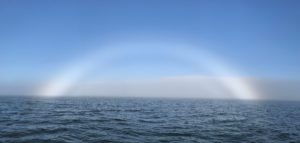 While we were boating through the fog, we observed a phenomenon that was new to both of us onboard. In the fog, we could clearly see what looked like a white rainbow; instead of a gradient of color, it had a slight gradient of light, and the ends were very bright! I later discovered that this is called a fog bow! Fog is caused by smaller water droplets than rain; because these droplets are so small, they can’t refract as much light as a raindrop, so the sunlight passing through is not able to separate into the usual colors we see in a rainbow. I had no idea this was possible, and seeing this fog bow was a definite highlight of the day!
While we were boating through the fog, we observed a phenomenon that was new to both of us onboard. In the fog, we could clearly see what looked like a white rainbow; instead of a gradient of color, it had a slight gradient of light, and the ends were very bright! I later discovered that this is called a fog bow! Fog is caused by smaller water droplets than rain; because these droplets are so small, they can’t refract as much light as a raindrop, so the sunlight passing through is not able to separate into the usual colors we see in a rainbow. I had no idea this was possible, and seeing this fog bow was a definite highlight of the day!
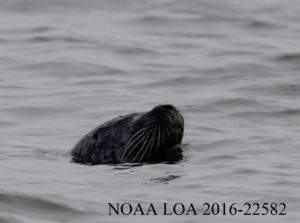 We saw a lot of gulls and ducks on the survey today, and the cormorants and seals have begun to disperse. We only saw 2 gray seals down at Fort Point and four grays and 22 harbor seals at Odom’s Ledge. We also documented some surf scoters, as well as black guillemots in non-breeding plumage today; all signs of fall. Conditions on the river will likely continue to change quickly as the weather cools down and the leaves begin to change.
We saw a lot of gulls and ducks on the survey today, and the cormorants and seals have begun to disperse. We only saw 2 gray seals down at Fort Point and four grays and 22 harbor seals at Odom’s Ledge. We also documented some surf scoters, as well as black guillemots in non-breeding plumage today; all signs of fall. Conditions on the river will likely continue to change quickly as the weather cools down and the leaves begin to change.
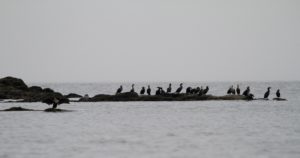

8/24/2020
We completed our final summer survey of the year today! The morning started out nice and calm, but by the time we reached Bucksport, we were surrounded by thick fog. We completed our transit south slowly while trying to pick channel markers out from the fog to make sure we stayed on track. We ended up floating offshore of Fort Point for awhile until the fog eventually cleared and we could see Fort Point Ledge.
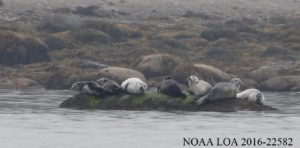
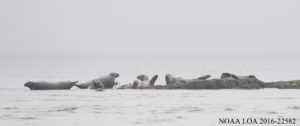

We saw a LOT of seals down at Fort Point: 30 gray seals and 5 harbor seals. We were able to get photos of 19 individuals and identified 5 of them as seals that we’ve seen before. We had 15 gray seals and 12 harbor seals at Odom’s Ledge with only 6 individuals photographed and 1 identified as an animal in our catalog. We also saw 22 harbor seals at the Eastern Shore haul-out site, which is the second-most we’ve ever documented in 9 years of this survey! This site tends to become popular for harbor seals when gray seals move start hanging out at Fort Point and Odom’s ledges. With so many gray seals at both haul-out locations today, it makes sense that we would see so many harbor seals over at the Eastern Shore.
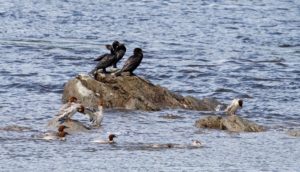
We saw over 450 ring-billed gulls, 6 great blue herons, and 15 common terns on this survey. The upper estuary also had several American black ducks swimming around…we counted over 200!! We have four fall surveys scheduled for this season and are interested to see how things continue to change on the river as the seasons change. My colleague is still convinced that winter will come early this year. Stay tuned!
08/07/2020
This week brought another beautiful summer day out on the Penobscot. There were a LOT of birds out on the estuary. We documented over 400 herring and ring-billed gulls, several Bonaparte’s gulls, common terns, a great blue heron, osprey, bald eagles (adults and juveniles), common mergansers, and American black ducks. We also saw over 30 Canada geese! In previous years, geese tend to show up in mid to late September. We didn’t document the arrival of geese until early October in 2019! My colleague that runs the estuary surveys is convinced that the early arrival of geese means an early winter this year.
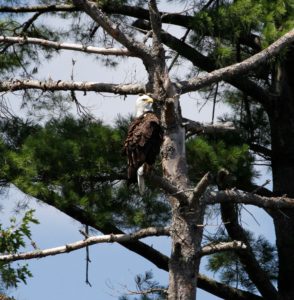
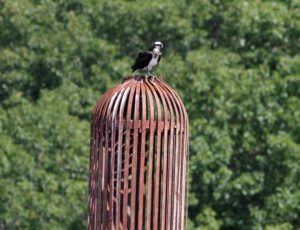

There were also a lot of pogies in the estuary during this survey! Lots of them were showing up in the hydroacoustic data, and we even saw one that was recently bitten in half (and still moving!), presumably by one of the seals in the area. The water was very flat and calm all day, which made for excellent viewing conditions. We were able to spot 7 gray seals and 11 harbor seals swimming, in addition to all the animals out on the rocks. On our southernmost haul-outs, we saw over 30 harbor seals and 11 gray seals. We were able to identify two harbor seals and four gray seals as animals that we have seen before.
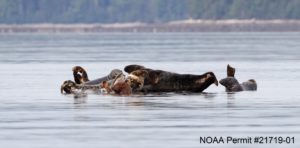
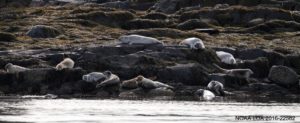
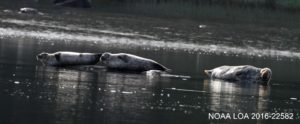
7/24/2020
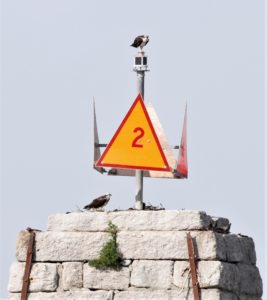 We got to spend another beautiful summer day on the water this week. There were 50 seals at Odom’s Ledge, which is one of the higher counts we’ve had this year. Both gray and harbor seals were present on the ledge; check out the photos and see if you can spot the gray seals!
We got to spend another beautiful summer day on the water this week. There were 50 seals at Odom’s Ledge, which is one of the higher counts we’ve had this year. Both gray and harbor seals were present on the ledge; check out the photos and see if you can spot the gray seals!
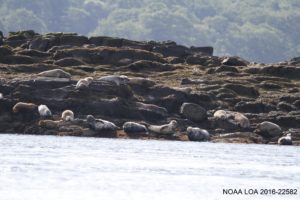
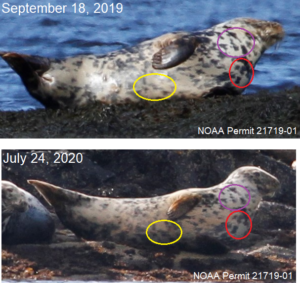 It was quiet down at Fort Point Ledge, with only seven seals hauled out. Between Odom’s Ledge and Fort Point Ledge, we were able to photograph 11 gray seals, and I was later able to identify six of them as seals we also saw last year. One of the seals was initially seen on June 20, 2019 and had not been identified since then! Another gray seal that we saw was initially seen on August 5, 2019 and has been seen four other times since then! One of the goals of our photo-identification work is to learn how individuals are using the river throughout the year, and it is exciting to see the same animals returning this year. Seals have unique patterns on their fur, and this is what we use to identify individual animals. If you look at the photos to the rigth, I have circled corresponding pelage patterns between two different sightings of the same animal. Each photograph is taken through our catalog and the pelage patterns are closely analyzed; we currently have 64 individual gray seals and 26 harbor seals in the catalog, so the matching process can be pretty time consuming (but rewarding too!)!
It was quiet down at Fort Point Ledge, with only seven seals hauled out. Between Odom’s Ledge and Fort Point Ledge, we were able to photograph 11 gray seals, and I was later able to identify six of them as seals we also saw last year. One of the seals was initially seen on June 20, 2019 and had not been identified since then! Another gray seal that we saw was initially seen on August 5, 2019 and has been seen four other times since then! One of the goals of our photo-identification work is to learn how individuals are using the river throughout the year, and it is exciting to see the same animals returning this year. Seals have unique patterns on their fur, and this is what we use to identify individual animals. If you look at the photos to the rigth, I have circled corresponding pelage patterns between two different sightings of the same animal. Each photograph is taken through our catalog and the pelage patterns are closely analyzed; we currently have 64 individual gray seals and 26 harbor seals in the catalog, so the matching process can be pretty time consuming (but rewarding too!)!
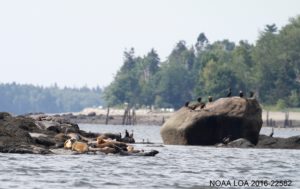
7/7/2020

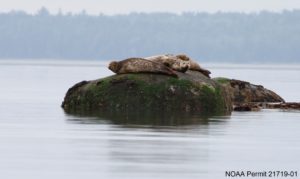 We had another great day on the water this week! There were a lot of seals in the southern part of the estuary…over 50 seals were seen at Odom’s Ledge and 40 were seen at Fort Point! Since harbor seal pupping season is now over, we began our photo-identification efforts for the season by circling Fort Point Ledge. We ended up photographing seventeen gray seals for identification and were able to recognize two of them as individuals that were seen last year. One of them, Hg005, was seen in July and September of 2019, while the other, Hg018, was seen five times in 2019 between August and October.
We had another great day on the water this week! There were a lot of seals in the southern part of the estuary…over 50 seals were seen at Odom’s Ledge and 40 were seen at Fort Point! Since harbor seal pupping season is now over, we began our photo-identification efforts for the season by circling Fort Point Ledge. We ended up photographing seventeen gray seals for identification and were able to recognize two of them as individuals that were seen last year. One of them, Hg005, was seen in July and September of 2019, while the other, Hg018, was seen five times in 2019 between August and October.
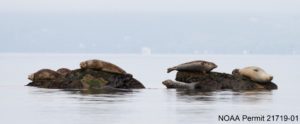
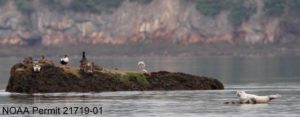
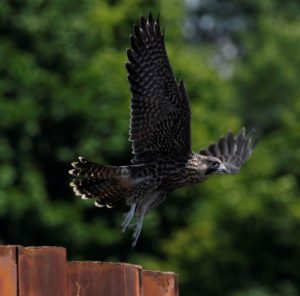 In addition to our seal observations, we had some great raptor sightings as well! Included in the photos are adult and juvenile bald eagles, as well as a photo of the bald eagle nest…the two chicks still seem to be doing well! The most exciting sighting of the day (for me at least!) was a peregrine falcon! This species has only been sighted once on the survey (back in May 2015) since it began back in 2011! After World War II, the use of pesticides, such as DDT, began to severely impact many raptor populations. These chemicals cause egg shells to be thinner than normal, resulting in adults crushing eggs while incubating them and subsequent reproductive failure. DDT was banned in the US back in 1972, but these chemicals still persist in the environment in South America where peregrine falcons spend the winter. Their comeback has been slow, but their endangered listing was removed in 1999, with the help of re-introduction programs. Today in Maine, the breeding population of peregrines is still listed on Maine’s Endangered Species Act. When peregrines breed, clutches of 3-4 eggs are typically laid in the spring. The eggs hatch in May and early June, and the chicks stay in the nest for six weeks until they fledge in late June and July. They will then stay at the nest with their parents as they learn to hunt through August. The peregrine in the photo is a juvenile, based on the thick vertical bars on the chest and the light-colored band at the tip of the tail feathers. This is likely a fledgling from a pair in Bangor that has been nesting here since 2013. Last year, this pair fledged two chicks, and it appears as though this year, they’ve fledged at least one! Fun fact about peregrine falcons: they can dive through the air at speeds up to 200 miles per hour!!
In addition to our seal observations, we had some great raptor sightings as well! Included in the photos are adult and juvenile bald eagles, as well as a photo of the bald eagle nest…the two chicks still seem to be doing well! The most exciting sighting of the day (for me at least!) was a peregrine falcon! This species has only been sighted once on the survey (back in May 2015) since it began back in 2011! After World War II, the use of pesticides, such as DDT, began to severely impact many raptor populations. These chemicals cause egg shells to be thinner than normal, resulting in adults crushing eggs while incubating them and subsequent reproductive failure. DDT was banned in the US back in 1972, but these chemicals still persist in the environment in South America where peregrine falcons spend the winter. Their comeback has been slow, but their endangered listing was removed in 1999, with the help of re-introduction programs. Today in Maine, the breeding population of peregrines is still listed on Maine’s Endangered Species Act. When peregrines breed, clutches of 3-4 eggs are typically laid in the spring. The eggs hatch in May and early June, and the chicks stay in the nest for six weeks until they fledge in late June and July. They will then stay at the nest with their parents as they learn to hunt through August. The peregrine in the photo is a juvenile, based on the thick vertical bars on the chest and the light-colored band at the tip of the tail feathers. This is likely a fledgling from a pair in Bangor that has been nesting here since 2013. Last year, this pair fledged two chicks, and it appears as though this year, they’ve fledged at least one! Fun fact about peregrine falcons: they can dive through the air at speeds up to 200 miles per hour!!
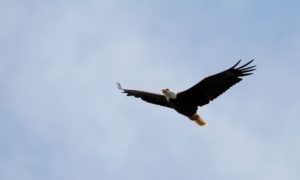
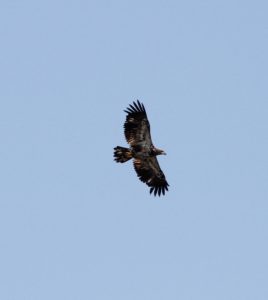
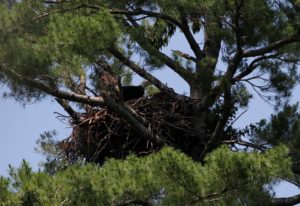
6/23/2020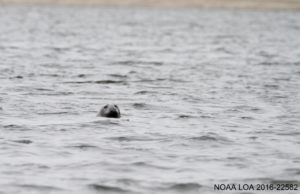
Despite the thick fog that started off our day, we had an exciting day out on the water this week. Luckily, the fog cleared while we were setting up our equipment down near Fort Point Ledge, so we were able to see the ledges and get counts of the seals by the time the survey started. The number of seals we are seeing out there is starting to decrease as we reach the end of harbor seal pupping season and enter summer; today we saw 18 harbor seals down at Fort Point and 20 harbor seals at Odom’s Ledge. We also had a swimming gray seal come scope out our boat while we were passing Odom’s Ledge.
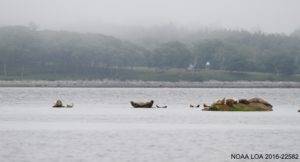
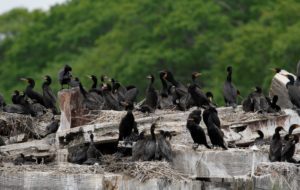 The estuary was packed with fish today, we got to see some jumping sturgeon, and we also had several fun bird sightings. We saw approximately 70 common eiders; these sea ducks are the largest duck in the northern hemisphere, and as you can see in the photo, the males are white and black, while the females are brown. The cormorant rookery was busier than normal today, as many of the chicks have hatched, and those babies seemed ravenous! Cormorants feed their chicks regurgitated fish, and you can see in the photo that one baby was so hungry, its entire head is down its parent’s throat!
The estuary was packed with fish today, we got to see some jumping sturgeon, and we also had several fun bird sightings. We saw approximately 70 common eiders; these sea ducks are the largest duck in the northern hemisphere, and as you can see in the photo, the males are white and black, while the females are brown. The cormorant rookery was busier than normal today, as many of the chicks have hatched, and those babies seemed ravenous! Cormorants feed their chicks regurgitated fish, and you can see in the photo that one baby was so hungry, its entire head is down its parent’s throat!
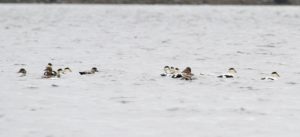
We saw five common loons today, which is more than normal, 17 osprey, many of which were on nests, and 8 bald eagles. As I mentioned in a previous post, it looks like all three bald eagle nests from last year are inactive this season. Today, we managed to find a new nest that had two chicks in it!! We aren’t sure if this is a new pair or if one of our pairs from last year moved; both upper estuary nest locations from last year are close to human development, so either option is possible. Personally, I’m just excited to have an active nest to follow for the rest of the season!
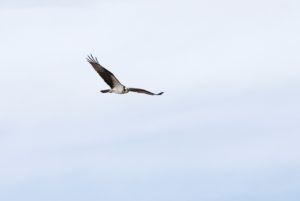
6/9/2020
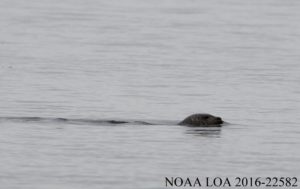
We spent a beautiful day out on the water this week. Even though the weather was cloudy and cool for most of the morning, we had glassy sea surface conditions, making it easier than normal to spot animals in the water. We saw two harbor porpoise swimming together between Odom’s Ledge and the Bucksport bridge this week! This was the first harbor porpoise sighting we’ve had since the Cammen Lab has been participating in the estuary survey; the last documented sighting was on 7/31/2018. We have colleagues that regularly see harbor porpoise in the Winterport area, and have documented 19 sightings of harbor porpoise during our survey between 2011 and 2019. Harbor porpoise are shy animals, so it’s not surprising that we don’t see them very often; they might be even more cryptic than normal when they can hear our hydroacoustic equipment.
The excellent conditions also allowed us to see several swimming seals. We documented a total of 43 harbor seals and 5 gray seals during this week’s survey. These sightings included what looked like 3 harbor seal pups and 3 recently weaned pups. We also saw our first recorded common merganser and broad-winged hawk of the season, and we noticed several chicks at the cormorant rookery (photos included)!
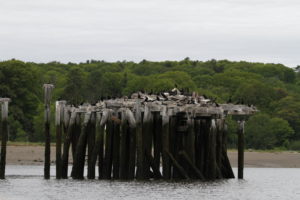
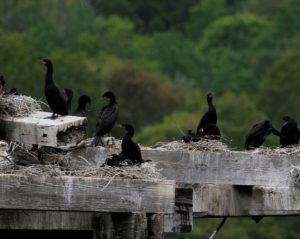
Now that we are entering mid-June and we are settling into summer conditions on the estuary, we will begin conducting our surveys every other week instead of weekly. Our next survey is scheduled for the week of June 22, when we are planning to begin some of this season’s gray seal photo-identification work…it will be interesting to see if some of the gray seals in the estuary were seen here last year!

6/2/20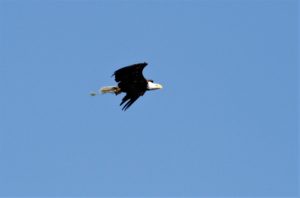
We had another successful day on the water this week, although it didn’t feel like June while we were bundled in winter hats, gloves, and face coverings unrelated to COVID-19. Despite the cold, we documented increased fish biomass from last week, and got to see bald eagles and osprey carrying materials to help build their nests back up after the high winds we had last Friday.
We had a lot of seals on Odom’s and Fort Point Ledges again this week, which is expected. Harbor seals in the northwest Atlantic give birth to pups along the coast of Maine between May and June. At this time of the year, we expect to see harbor seals spending more time out on the rocks. Here in the Penobscot River Estuary, we see more harbor seals during this time of year than we do during the rest of our survey season, which runs through October. Peak harbor seal season is an exciting time to survey the ledges, and again this week, we had the opportunity to see several harbor seal pups. As always, we kept our distance to prevent disturbance to these animals.

Our photo-identification work has been limited so far this year, mainly because we are keeping extra distance from the haul-outs during pupping season. This week, however, we did re-sight a known animal at Buck’s Ledge. This harbor seal was seen three times last year during the month of May at this same ledge; his last documented sighting was May 28, 2019. It was exciting to see him alive and well again this year!
5/27/20
We had some fog in Stockton Springs during our survey this week, but luckily it  cleared while we were setting up our equipment and it turned into a beautiful day. There were about 50 seals down on Fort Point Ledge, and in our photo analysis after the survey, we were surprised to find six gray seals mixed in among the harbor seals! We didn’t see gray seals hauled out on this ledge until July last year, so this finding was unexpected and exciting to document.
cleared while we were setting up our equipment and it turned into a beautiful day. There were about 50 seals down on Fort Point Ledge, and in our photo analysis after the survey, we were surprised to find six gray seals mixed in among the harbor seals! We didn’t see gray seals hauled out on this ledge until July last year, so this finding was unexpected and exciting to document.
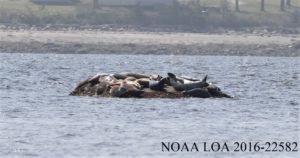 At Odom’s Ledge, we had fewer animals than last week, but spotted two seal pups on the ledge again this survey. There was a lot more fish biomass in the river this week, and water temperatures in the river were up 8 degrees from last week; the river is warming fast and everything is coming alive with spring. Other sightings from the survey included common eiders, a common loon pair near Orrington, a bald eagle near a nest in Hampden, and several active osprey nests in Bucksport.
At Odom’s Ledge, we had fewer animals than last week, but spotted two seal pups on the ledge again this survey. There was a lot more fish biomass in the river this week, and water temperatures in the river were up 8 degrees from last week; the river is warming fast and everything is coming alive with spring. Other sightings from the survey included common eiders, a common loon pair near Orrington, a bald eagle near a nest in Hampden, and several active osprey nests in Bucksport.
5/19/2020
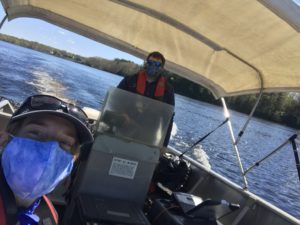
Our field season got off to a late start this year due to the pandemic, but we were able to implement new protocols to keep the crew as safe as possible during surveys and conducted our first survey this week! It was a beautiful day to be out on the water; sun, no wind, and glassy water until our last couple tracklines of the day…it helped make six hours of wearing a mask more manageable.
Things were pretty quiet on the river. We did not see many birds, especially up north, and our three eagle nests from last year either looked unoccupied or were gone. The cormorant rookery was busy with over 150 individuals, and we saw several scoters and osprey as well. We counted approximately 40 harbor seals on Odom’s Ledge, and documented two harbor seal pups!
Things on the river start changing fast in the spring as water temperatures start warming, so we’re excited to see what each new week brings as the season goes on.
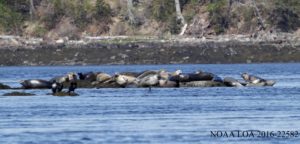
10/16/2019
What began as a cold, fo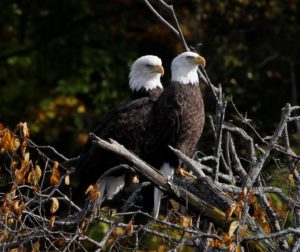 ggy day turned into a beautiful afternoon on the river, complete with colorful foliage and glassy seas. Luckily for us, the fog lifted right before we arrived at Odom’s Ledge. Nine gray seals and 18 harbor seals were spotted at the ledge. Fort Point was a bit quieter than normal. There was only one harbor seal and one gray seal hauled out at this ledge, with a few more animals swimming in the area.
ggy day turned into a beautiful afternoon on the river, complete with colorful foliage and glassy seas. Luckily for us, the fog lifted right before we arrived at Odom’s Ledge. Nine gray seals and 18 harbor seals were spotted at the ledge. Fort Point was a bit quieter than normal. There was only one harbor seal and one gray seal hauled out at this ledge, with a few more animals swimming in the area.
We had several exciting bird sightings during this week’s survey as well! Lots of white-winged and surf scoters have moved into the lower part of the estuary, and we’re still seeing several flocks of mallards further upriver. We saw our first black guillemot of the season down at Fort Point, and we spotted our first buteo hawk of the season as well. We also got some great looks at a pair of bald eagles in Hampden…check out the photos below!
As the seasons change, our season is slowly coming to a close. We have one survey left this year, scheduled to take place at the end of October. Stay tuned!
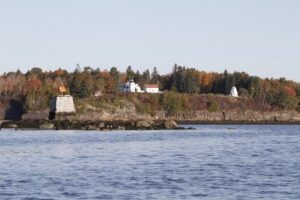
10/02/2019
It was another cold day out on the river this week…things are changing fast!
In addition to our vessel surveys, I am also conducting land-based surveys of Buck’s Ledge. Over the past couple months, there have been a handful of “regulars” that hang out at this ledge. In addition to the number that gets assigned to seals in the identification catalog, I have given these ones nicknames to help me recognize and identify them in the field. During our boat survey today, we had three harbor seals on Buck’s Ledge: Fido, Batman, and Horseshoe. See photos of these three below…I’ve circled the patterns in their pelage that inspired their nicknames.
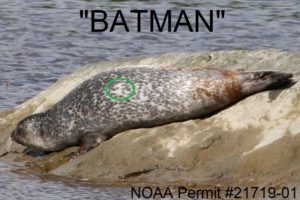

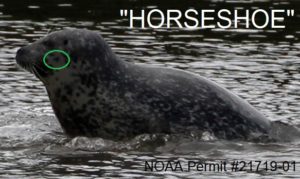
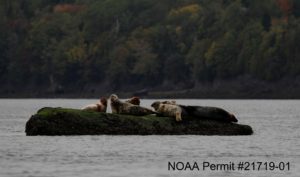
Both Odom’s and Fort Point ledges were busy today. Odom’s had six gray seals and ten harbor seals hauled out, while Fort Point had ten gray seals. Many of these gray seals were photographed, but surprisingly, none of them were matched to animals in the identification catalog! This brings the total number of gray seals in the catalog up to 43 individuals (there are 21 harbor seals in the catalog).
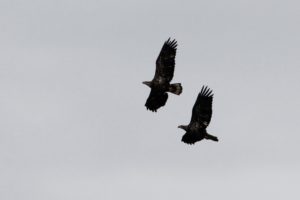
We had some interesting eagle sightings too! On our transit south, we saw an eagle onshore eating a large fish!
Towards the end of the survey, we saw two juvenile eagles flying and twirling around together in the air. They eventually joined up with two adult eagles, and all four were riding the thermals like turkey vultures…very cool!
09/23/2019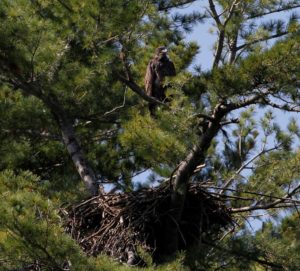
It certainly felt like fall on the river last week! Thanks to a cold wind from the north, we were bundled up in hats and winter jackets. Despite the cold, it was a beautiful day out on the river. Most of our osprey nests were empty this week, but we still had a juvenile bald eagle hanging out near its nest.
There were still lots of seals hanging around on both Odom’s Ledge and Fort Point Ledge. At Fort Point, there were five gray seals hauled out together on the rocks near the southern portion of the ledge, and a harbor seal was hauled out further up the west side. All six animals were new additions to our photo-identification catalogs.
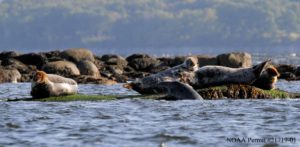
On Odom’s Ledge, we saw three gray seals and eight harbor seals on the southern side of the ledge. We were able to get good quality photographs of four of them, including one harbor seal that was a re-sight from August 5! This was our first successful harbor seal re-sighting at Odom’s Ledge this season!
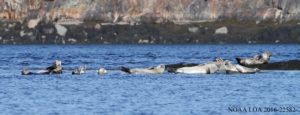
We have also been collaborating with partners in the Cammen Lab on an environmental DNA (eDNA) project. Since animals leave DNA in their environment (e.g., skin cells slough off in the water as an animal swims), we have been trying to extract seal DNA from water around the haul-outs in hopes of developing less invasive ways of studying these animals. All summer, we have been collecting water samples at various locations and distances from the haul-out sites. Once back in the lab, our lab technicians filter the water samples. DNA is extracted, amplified, and sent out for sequencing to confirm the species. This process requires a lot of trial and error, as these methods have never been applied to seals before! In August, we successfully detected harbor seal DNA in our samples. This week, we focused on trying to obtain samples of gray seal DNA. We collected samples from both Fort Point and Odom’s Ledge, and are looking forward to seeing the results once these samples have been processed!
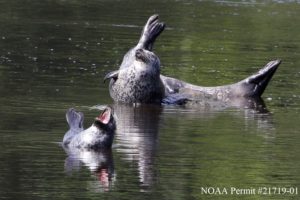
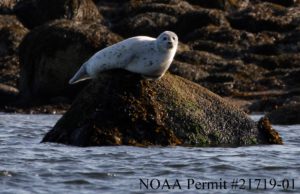

09/05/2019
We conducted our first fall survey of the season yesterday! Things are changing fast out on the river…the weather was chilly, some leaves were just starting to change, and our big cormorant rookery has mostly cleared out. We have three eagle nests along our survey route, and all of the eagle chicks are now out of the nest and flying around nearby.
We unfortunately did not have much luck with the seals this survey. It was very rough on the water during our transit south, making it very difficult to take any photos, and making it dangerous to approach the haul-outs too closely. We didn’t know if we were going to make it to the southern end of our survey route, but we pushed on, and luckily, the sea state calmed down once we reached Fort Point. There was only one harbor seal hauled out down there, so we were able to photograph that animal, as well as a swimming gray seal, who was matched to a seal spotted on Odom’s Ledge back in July. Many of the seals we typically see at Fort Point haul out on the rocks in the southern portion of the ledge; with such a strong southerly wind and waves hitting those rocks, it’s not surprising that the seals were elsewhere.
Hopefully our next survey will bring nicer weather and more seals!

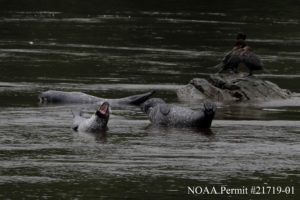
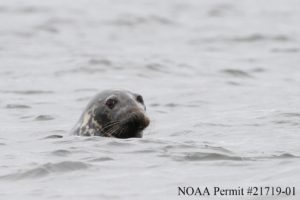
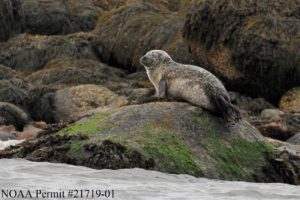
8/19/2019
Our field season on the Penobscot River began on May 1, 2019, and we have recently completed our ninth and final survey of the summer. Even though the summer seems to be winding down, our survey season is still in full swing; we have five fall surveys scheduled and are aiming to be out on the water until November 1.
We have had a great season so far. This survey has been regularly conducted by the Northeast Fisheries Science Center since 2012, but this has been the first season that has included seal-focused research. In addition to documenting seal sightings throughout the survey and on the three major haul-out sites along our survey route, we have been photographing seal haul-out sites in order to obtain more accurate counts, to better document species present, and to record any entanglements, wounds, and shark interactions. We have also focused our efforts on obtaining high quality images of individuals in hopes of being able to individually identify and track animals over time. So far, we have re-sighted two harbor seals and one gray seal.
Possibly as a result of our more dedicated seal survey efforts, we documented harbor seal pups in the estuary for the first time since the survey began. Pups were documented historically by aerial survey teams; the most recent data we have is from 2001, so it was exciting to confirm that the harbor seals are still pupping on these ledges.
Another interesting difference between this season and previous ones involves the presence of gray seals. We have seen an influx of gray seals into the estuary since the beginning of July. Between 2012 and 2018, only three gray seals were observed out on the rocks. This season, Fort Point Ledge has become dominated by gray seals; we had one week where 20 of these animals were hauled out on the rocks, with even more swimming in the water around the ledges. Odom’s Ledge has also seen an increase in gray seal presence: on our last survey, almost half of the animals present were grays.
The river seems to be constantly changing, and we’re excited to see what the rest of our season brings. Stay tuned for more updates this fall!
This project was funded in part by the Maine Outdoor Heritage Fund, in which proceeds from the sale of a dedicated instant lottery ticket are used to support outdoor recreation and natural resource conservation.For more information about MOHF, go to www.maine.gov/ifw/mohf.
